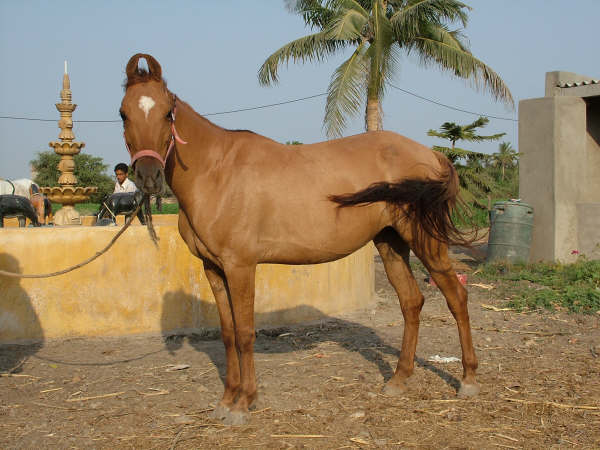Type the name of the breed you're looking for below
[wpdreams_ajaxsearchlite] Don't see the breed your're looking for? Click here and let us know!
Kathiawari horse
| Country Of Origin | India |
| History and Background | Although the earliest origins of the breed remain unknown, horses inhabited the western coast of India well before the Mughal Emperors of 1536 to 1857. Beginning during the Mughal reign, and continuing during the British Raj, Arabian horses were imported to India and crossed with the native stock, creating the ancestors of the modern Kathiawari breed. The Kathiawari may have also been influenced by the Mongolian horse. Traditionally, noble households specialized in their own strain of horses, naming their lines of horses after a foundation mare; 28 of these lines still exist. These noble houses selectively bred horses that could withstand extreme temperatures and minimal rations, carry a man with weapons and armor for long periods in rough terrain, and still be swift and nimble. They bred for wiry, sleek horses that were ideal for war, and Kathiawaris were noted for their loyalty and bravery in battle, often defending their riders even when wounded themselves. This breeding was maintained until India's independence. Although still mainly bred in the Kathiawar peninsula, it is also found in the Maharashtra and Rajasthan states. The Kathiawari Horse Breeders' Association maintains the breed registry. The Gujarat government maintains stud farms in eleven different locations; one in Junagadh holds both mares and stallions and is tasked with preserving the breed, while the other ten hold Kathiawari stallions that are used for improving the local stock of other or mixed breeds. As of 2007, only about 50 Kathiawaris were held by private breeders. Today, the Panchaal region is renowned for its Kathiawari horses, often producing the most beautiful horses of the breed. In early 2010, the UK-based Friends of Marwari/Kathiawari Horse asked for donations of used bits. These would be given to owners of horses, including Kathiawaris, in India in place of home-made bits, which often have sharp edges that can injure the horse. |
| Use Today | Agriculture work, Competition horse, General riding, Military horses |
| Height | Under 15 hands (60 inches, 152 cm) |
| Colour | Any colour |
| Characteristics | The best quality Kathiawaris are under 15 hands (60 inches, 152 cm); horses over this height often appear coarse and deviate from the desired breed type. The breed is found in all colours, except for black. Chestnut is the colour seen most often, followed by bay, gray and finally dun. Many dun horses exhibit primitive markings, which shows a possible connection to the Tarpan. Pinto patterns do exist, but are extremely rare. The breed has a concave facial profile, with a broad forehead and short muzzle. The neck and body are proportional and relatively short, while both the head and tail are carried high. Although well-proportioned, many Western breeders consider them to be lacking in bone in the legs. However, soundness is an inherent characteristic of the breed. One of the breed's most distinctive features is its ears, which curve inward to touch and sometimes overlap at the tips. The Kathiawari has the most extremely curved ears of any breed of horse. At some points in the breed's history, breeders focused on the preservation of these curving ears, to the detriment of some other, more important, physical characteristics. Like many desert breeds, the Kathiawari can subsist on minimal rations and water and is more resistant to the heat than breeds developed in colder climates. As well as the usual gaits, the Kathiawari also performs a swift, lateral pace, called the revaal. They are quite similar to the Marwari horse, another breed from India, having much of the same history and physical features. The main difference between the Kathiawari and the Marwari is their original geographic origin – Kathiawaris are from the Kathiawar peninsula while Marwaris are mainly from the Marwar region. Kathiawaris tend to have slight facial differences from the Marwari, and are slightly taller in general. The Kathiawari also resembles the Arabian horse, which contributed significantly during the development of the breed. |
| Personality and Temperament | They are known as high-spirited, intelligent and affectionate horses. |



